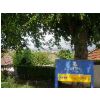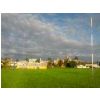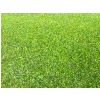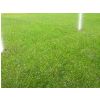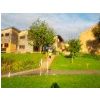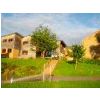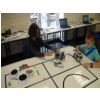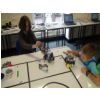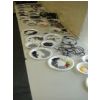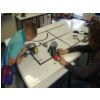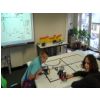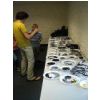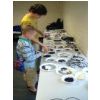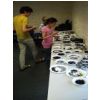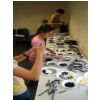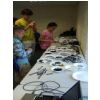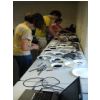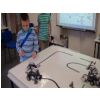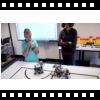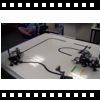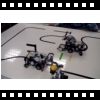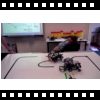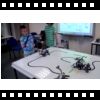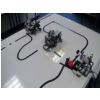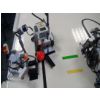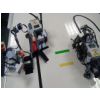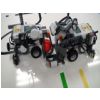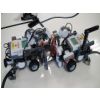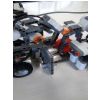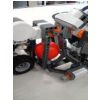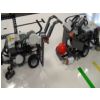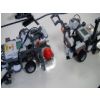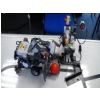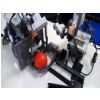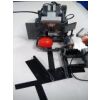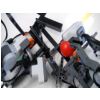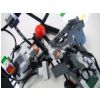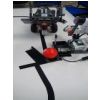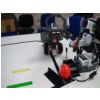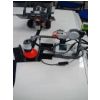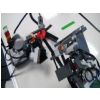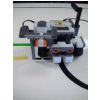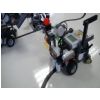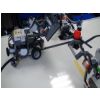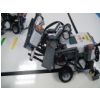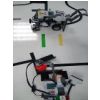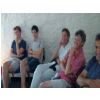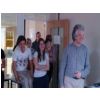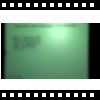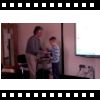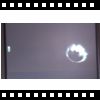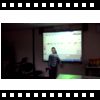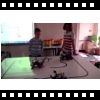Second Educational Robotics International Summer Course by BOGATECH and LMFL at Queen's College, Tauton, UK
31-07 to 13-08-12
For the second time, BOGATECH Educational Robotics Workshop and Language and Music For Life (LMFL) organized in collaboration the Educational Robotics International Summer Course at Queen's College, Tauton, United Kingdom. The intensive course is organized in daily sessions of three hours. The course is taught in English and is a very good language practice for the international students. For native English students, the course can also be taught in three other different languages (French, Spanish and Catalan). The course is structured in two different parts, the first week it covers a full program that allows students to get the knowledge and experience to build and program autonomous robots, and the second week the students develop a common project that offers them an opportunity to put together the knowledge acquired and to work in teams.
This year, the theme of the project was inspired on Mars robot, Curiosity, that NASA send to land on Mars by August 5. In fact, that day around 20 students and some teachers got together in the music hall to watch live the landing of Curiosity on Mars. We watch different videos from previous robots, like Spirit and Opportunity, and the NASA's video “7 minutes of terror” about Curiosity's landing process and system, just before the real event. It was a great and unique experience.
Giving students real scientific subjects to build their projects connects them to the real world of science, helps them to frame their work with real research studies and it is extremely encouraging and exciting. It is also an opportunity to realize that understanding science can be done at different levels and by anyone with enough desire and perseverance.
The students built three different types of robots with different levels of difficulty. The first robot represented Curiosity after landing on Mars. This robot had to go take a rock sample of Mars (a color ball) to bring to Spirit, one of the first Mars explorers. This robot used an ultrasonic sensor to detect Spirit and used two light sensors to follow the line and detect intersections. Spirit, the second robot, a little bit simpler than Curiosity, had to deliver the rock to the robot analyzer. This robot was provided with only one light sensor to follow the line, an ultrasonic sensor to detect Curiosity and used a touch sensor to detect the robot analyzer. The third robot, the analyzer, had to analyze the rock, symbolized by a changing color ball, by saying its color and sending a message to the Earth, by turning on its lights. This last robot used an ultrasonic sensor to detect Spirit and a light sensor to determine the color of the ball. The whole process could be repeated infinitely.
In the final public presentation, the students explained the audience how to program a simple robot, the challenge, the construction and computer programs of the robots, and at the end, they made a live demo of the challenge. This final exercise is designed to put together all the concepts learnt during the course and it is about learning, more than solving successfully the exercise, and developing the ability and skills to explain the individual work and team work as well as the technical and strategic issues involved in the project.
Per segona vegada, el Taller de Robòtica Educativa BOGATECH i Language and Music For Life (LMFL) van organitzar en col·laboració el Curs Internacional d'Estiu de Robòtica Educativa al Queen's College de Tauton al Regne Unit. El curs intensiu s'organitza amb sessions diàries de tres hores. El curs es fa en anglès i és una molt bona forma de practicar la llengua pels alumnes internacionals. Pels alumnes anglesos natius, el curs es pot impartir en tres altres llengües (francès, castellà i català). El curs s'estructura en dues parts diferents, la primera setmana cobreix un programa complert que permet als alumnes adquirir el coneixement i experiència per construir i programar robots autònoms, i la segona setmana els alumnes desenvolupen un projecte comú que els hi ofereix l'oportunitat d'ajuntar els coneixements adquirits i de treballar en equip.
Aquest any, el tema del projecte es va inspirar en el robot de Mars, Curiosity, que la NASA va enviar per aterrar sobre Mars el 5 d'agost. De fet, aquest dia uns 20 alumnes i alguns professors ens vàrem ajuntar a l'auditori per seguir en viu l'aterratge de Curiosity a Mars. Vàrem mirar diferents vídeos de robots anteriors, com Spirit i Opportunity, i el vídeo de la NASA, “7 minutes of terror” que explica el procés i sistema d'aterratge de l'Opportunity, just abans l'esdeveniment real. Va ser una gran i única experiència.
Utilitzar temes científics reals per construir els seus projectes connecta els estudiants amb el món real de la ciència, els ajuda a encaixar el seu treball amb els estudis de recerca reals i és extremadament motivador i excitant. També suposa una oportunitat per adonar-se que entendre la ciència es pot fer a diferents nivells y per qualsevol persona amb suficient desig i perseverança.
Els estudiants varen construir tres tipus diferents de robots amb diferents nivells de dificultat. El primer robot representava a Curiosity després d'aterrar sobre Mars. Aquest robot tenia que anar a buscar una mostra de roca marciana (una pilota de color) i entregar-la a Spirit, un dels primers exploradors de Mars. Aquest robot utilitzava un sensor ultrasònic per detectar Spirit i utilitzava dos sensors de llum per seguir una línia i detectar interseccions. Spirit, el segon robot, una mica més senzill que Curiosity, tenia que entregar la roca al robot analitzador. Aquest robot comptava amb només un sensor de llum per seguir la línia, un sensor ultrasònic per detectar Curiosity i utilitzava un sensor de tacte per detectar el robot analitzador. El tercer robot, l'analitzador, tenia que analitzar la roca, simbolitzada per una pilota de colors canviants, dir el seu color i enviar un missatge a la Terra, encenent les seves llums. Aquest últim robot utilitzava un sensor ultrasònic per detectar Spirit i un sensor de llum per determinar el color de la pilota. Tot aquest procés es podia repetir infinitament.
En la presentació pública, els alumnes varen explicar a l'audiència cóm programar un robot simple, el repte, la construcció i programació dels robots, i al final, varen fer una demostració en directe del repte. Aquest exercici final està dissenyat per ajuntar tots els conceptes apresos durant el curs on es tracta d'aprendre, més que de solucionar exitosament l'exercici, i de desenvolupar l'habilitat i aptituds per explicar el treball individual i en equip així com els temes tècnics i estratègics continguts en el projecte.
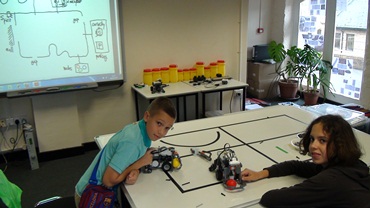
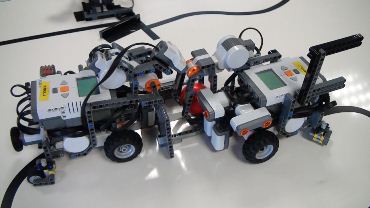
This year, the theme of the project was inspired on Mars robot, Curiosity, that NASA send to land on Mars by August 5. In fact, that day around 20 students and some teachers got together in the music hall to watch live the landing of Curiosity on Mars. We watch different videos from previous robots, like Spirit and Opportunity, and the NASA's video “7 minutes of terror” about Curiosity's landing process and system, just before the real event. It was a great and unique experience.
Giving students real scientific subjects to build their projects connects them to the real world of science, helps them to frame their work with real research studies and it is extremely encouraging and exciting. It is also an opportunity to realize that understanding science can be done at different levels and by anyone with enough desire and perseverance.
The students built three different types of robots with different levels of difficulty. The first robot represented Curiosity after landing on Mars. This robot had to go take a rock sample of Mars (a color ball) to bring to Spirit, one of the first Mars explorers. This robot used an ultrasonic sensor to detect Spirit and used two light sensors to follow the line and detect intersections. Spirit, the second robot, a little bit simpler than Curiosity, had to deliver the rock to the robot analyzer. This robot was provided with only one light sensor to follow the line, an ultrasonic sensor to detect Curiosity and used a touch sensor to detect the robot analyzer. The third robot, the analyzer, had to analyze the rock, symbolized by a changing color ball, by saying its color and sending a message to the Earth, by turning on its lights. This last robot used an ultrasonic sensor to detect Spirit and a light sensor to determine the color of the ball. The whole process could be repeated infinitely.
In the final public presentation, the students explained the audience how to program a simple robot, the challenge, the construction and computer programs of the robots, and at the end, they made a live demo of the challenge. This final exercise is designed to put together all the concepts learnt during the course and it is about learning, more than solving successfully the exercise, and developing the ability and skills to explain the individual work and team work as well as the technical and strategic issues involved in the project.
Per segona vegada, el Taller de Robòtica Educativa BOGATECH i Language and Music For Life (LMFL) van organitzar en col·laboració el Curs Internacional d'Estiu de Robòtica Educativa al Queen's College de Tauton al Regne Unit. El curs intensiu s'organitza amb sessions diàries de tres hores. El curs es fa en anglès i és una molt bona forma de practicar la llengua pels alumnes internacionals. Pels alumnes anglesos natius, el curs es pot impartir en tres altres llengües (francès, castellà i català). El curs s'estructura en dues parts diferents, la primera setmana cobreix un programa complert que permet als alumnes adquirir el coneixement i experiència per construir i programar robots autònoms, i la segona setmana els alumnes desenvolupen un projecte comú que els hi ofereix l'oportunitat d'ajuntar els coneixements adquirits i de treballar en equip.
Aquest any, el tema del projecte es va inspirar en el robot de Mars, Curiosity, que la NASA va enviar per aterrar sobre Mars el 5 d'agost. De fet, aquest dia uns 20 alumnes i alguns professors ens vàrem ajuntar a l'auditori per seguir en viu l'aterratge de Curiosity a Mars. Vàrem mirar diferents vídeos de robots anteriors, com Spirit i Opportunity, i el vídeo de la NASA, “7 minutes of terror” que explica el procés i sistema d'aterratge de l'Opportunity, just abans l'esdeveniment real. Va ser una gran i única experiència.
Utilitzar temes científics reals per construir els seus projectes connecta els estudiants amb el món real de la ciència, els ajuda a encaixar el seu treball amb els estudis de recerca reals i és extremadament motivador i excitant. També suposa una oportunitat per adonar-se que entendre la ciència es pot fer a diferents nivells y per qualsevol persona amb suficient desig i perseverança.
Els estudiants varen construir tres tipus diferents de robots amb diferents nivells de dificultat. El primer robot representava a Curiosity després d'aterrar sobre Mars. Aquest robot tenia que anar a buscar una mostra de roca marciana (una pilota de color) i entregar-la a Spirit, un dels primers exploradors de Mars. Aquest robot utilitzava un sensor ultrasònic per detectar Spirit i utilitzava dos sensors de llum per seguir una línia i detectar interseccions. Spirit, el segon robot, una mica més senzill que Curiosity, tenia que entregar la roca al robot analitzador. Aquest robot comptava amb només un sensor de llum per seguir la línia, un sensor ultrasònic per detectar Curiosity i utilitzava un sensor de tacte per detectar el robot analitzador. El tercer robot, l'analitzador, tenia que analitzar la roca, simbolitzada per una pilota de colors canviants, dir el seu color i enviar un missatge a la Terra, encenent les seves llums. Aquest últim robot utilitzava un sensor ultrasònic per detectar Spirit i un sensor de llum per determinar el color de la pilota. Tot aquest procés es podia repetir infinitament.
En la presentació pública, els alumnes varen explicar a l'audiència cóm programar un robot simple, el repte, la construcció i programació dels robots, i al final, varen fer una demostració en directe del repte. Aquest exercici final està dissenyat per ajuntar tots els conceptes apresos durant el curs on es tracta d'aprendre, més que de solucionar exitosament l'exercici, i de desenvolupar l'habilitat i aptituds per explicar el treball individual i en equip així com els temes tècnics i estratègics continguts en el projecte.


